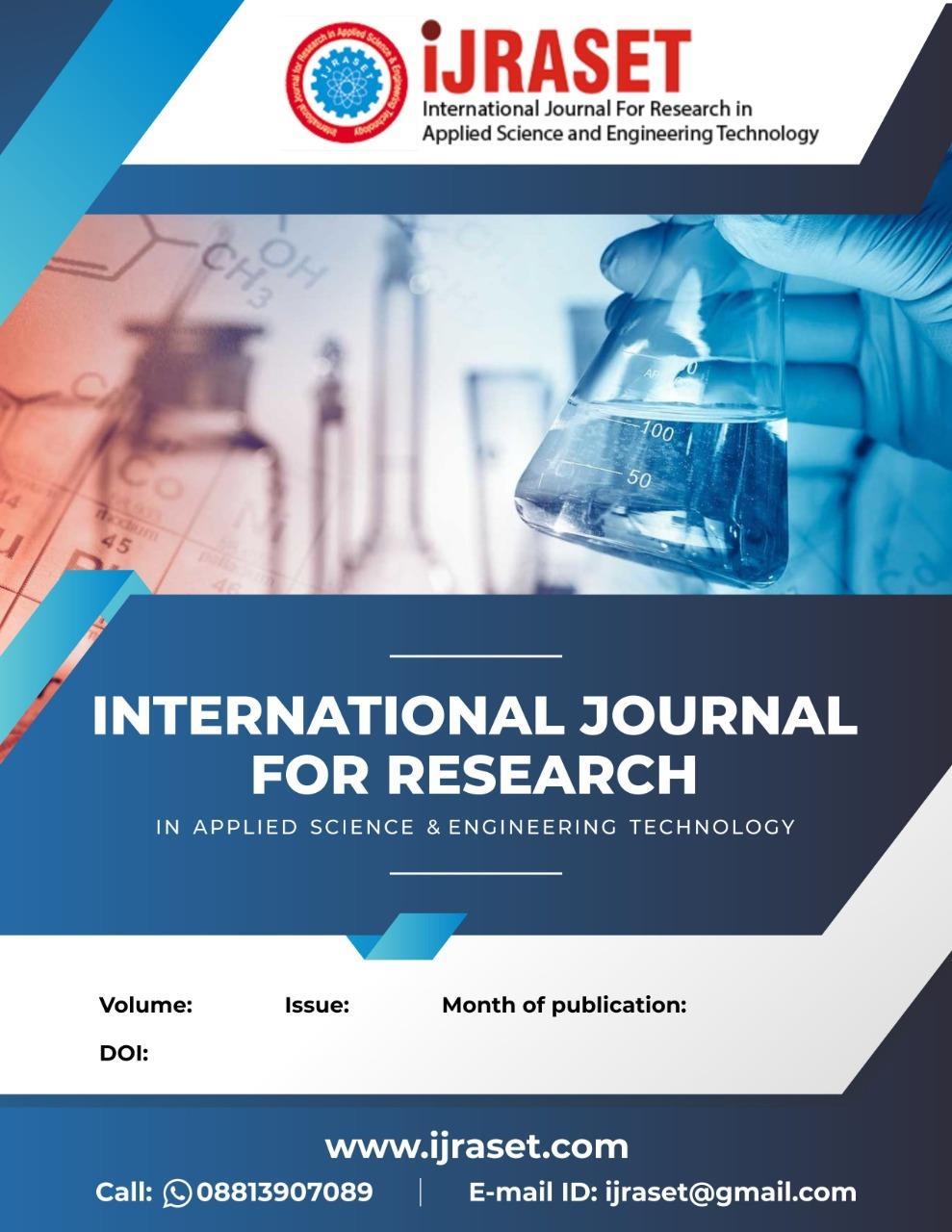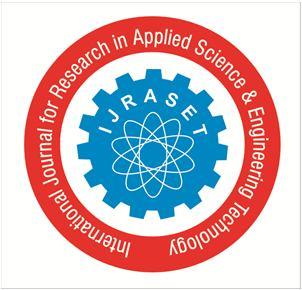https://doi.org/10.22214/ijraset.2023.50443

ISSN: 2321-9653; IC Value: 45.98; SJ Impact Factor: 7.538

Volume 11 Issue IV Apr 2023- Available at www.ijraset.com

https://doi.org/10.22214/ijraset.2023.50443

ISSN: 2321-9653; IC Value: 45.98; SJ Impact Factor: 7.538

Volume 11 Issue IV Apr 2023- Available at www.ijraset.com
Abstract: Hazardous chemicals have the potential to purpose poisonous effects on human being. Industrial hygiene is the take a look at of the way to anticipate, understand, evaluate, and control of administrative centre situations which could result in people experiencing illness or injury. This take a look at goals to design what is the entire bodily category of airborne contaminants because of chemical compounds directly and circuitously in to our frame. Considering the importance of hygiene in occupational exposure to active pharmaceutical ingredient (API) may cause unintended health impacts in the handling of these drugs by employees. In an industrial setting, where a worker offers a route of exposure to a powerful chemical compound, there is a high likelihood or risk that the compound will produce the designed response. Industrial hygiene offers needed policies to prevent occupational exposure to powerful compounds and elements of a good powerful safety program for compounds. Industrial hygiene is all about anticipating and assessing the hazards of powerful compounds; determining which of the procedures present the greatest risks; assessing the risks; and controlling future occupational exposures mainly through engineering and administrative systems. all safety precautions should be introduced and failure of control exposures to powerful compounds may result in expensive program mistakes, delayed manufacturing schedules and possibly dangerous exposures to industrial employees.
Keywords: Data collection, Hazard characterization, OEB wise characterization Hazard Labelling, Qualitative Risk Assessment (QRA), Quantitative Exposure Assessment (QNEA), Velocity measurement, Personal noise dosimetry, Respiratory Fit Test.
In this project, we have performed for an industry to identified and evaluate workplace health hazards by personal & work place exposure monitoring. To concerned with the prevention & control of occupational health hazards that arise as a result of or during work. To suggested an engineering, work practice control, and other methods to control potential health hazards to work towards improving employee health, safety and well-being.

Industrial Hygiene has been defined by AIHA as “that science and art devoted to the Anticipation, Recognition, Evaluation and control of those environment factors or stresses arising in or from the workplace, which may cause sickness, impaired health and well-being, or significant discomfort among workers or among citizen of the community the employees.’’.
Place of Occupational Hygiene in Occupational Health


ISSN: 2321-9653; IC Value: 45.98; SJ Impact Factor: 7.538
Volume 11 Issue IV Apr 2023- Available at www.ijraset.com
B. Objective


Works Co-ordination between Industrial Hygiene, Medical Officer & Safety Officer for the purpose of Safety & Health Industrial Hygienist will carry out personal monitoring & report individual exposure. Safety Officer will study the IH report and check the feasibility of recommended control measure. Medical officer will examine the worker for effect of exposure and suggest the need biological monitoring as well as give medical guidance. Work of IH is useful to health physician in drawing conclusion for occupational disease

A. Introduction
The industrial hygiene program is integrated system to develop in industry to make the employee health and safety in workplace. It’s the Responsibility of Industrial Hygienist includes such as Hazard communication. Qualitative and qualitative health risk assessment Carry out personal and workplace exposure monitoring by adopting standard IH practices Giving recommendations to control and reduce the exposures below exposure limits Provide training to employment on occupational health hazards Increase productivity and employee efficiency by protecting and promoting employee’s health.



ISSN: 2321-9653; IC Value: 45.98; SJ Impact Factor: 7.538
Volume 11 Issue IV Apr 2023- Available at www.ijraset.com
The following process in the Integrated Industrial hygiene Program.
1) Data Collection: Data collection is process of collection of the required data from different corresponding reliable sources. MSDS of sigma Aldrich, Chem watch MSDS and science lab can be referred for data collection of hazard characterization of different chemicals.
2) Hazard Characterization: Hazard characterization is evaluation of collected data according to the nature and properties of particular chemical and hazards associated with it. Data can be Categorize data in to following categories: Carcinogenicity data, Reproductive data, Toxicity data, Corrosive data, Flammability Data., Reactivity data
3) OEB Wise Characterization: A mechanism to quickly and accurately assign chemicals into “categories” or “bands” based on their health outcomes and potency considerations.
OEB 1 OEB 2 OEB 3 OEB 4 OEB 5
Least hazardous → Most Hazardous
4) Hazard Labelling: Hazard labeling is being done to provide guidance in the development, implementation and maintenance of an effective Hazard Labeling plan. Hazard labeling incudes following data: Material Name, Manufacturer’s Name and Address, CAS Number, Emergency Contact Number, Signal Word, Hazard Classification, Hazard Statement, Precautionary Statement, Pictogram
5) Qualitative Risk Assessment (QRA): Qualitative risk assessment is evaluation of potential personal exposure to workplace chemicals, physical, radiological, and/or biological agents based on personal experience and professional judgment. Qualitative assessment mainly focused on following parameters., Area, Unit operation/process, Duration of exposure, Quantity per batch or Activity, Physical form of material, Hazard classification
6) Quantitative Exposure Assessment (QNEA): QNEA is evaluation of actual personal workplace exposure to chemical, physical, radiological, and/or biological agents using accredited numerical and mathematical analysis. QNEA can be planned based on results of QRA. It is being performed to measure personal exposure. This includes: Media selection, low rate setting, Calibration, Personal exposure monitoring, Sending sampled media to the laboratory, Results
7) Velocity Measurement: Velocity measurement is the quantification of Air flow. Air flow can be measured in a variety of ways. Velometer is being used for measurement of Air flow. Velocity measurement Includes measurement of capture velocity, duct velocity and face velocity.
8) Personal Noise Dosimetry: Every worker who is exposed to or likely to be exposed to high noise levels shall be included in the noise monitoring exercise. The noise monitoring exercise refers to performing personal noise dosimeter measurement which involves in the measurement of individual workers noise exposure level using personal dosimeter. Noise Monitoring includes area selection for Personal Dosimetry, Calibration of Personal Dosimeters, personal Noise Monitoring and results.
9) Respiratory Fit Test: It is 10-15 minutes test to check whatever respirator is being used by person/worker/employee is fit for that particular person or not. Selection of test Agent, Hood preparation, Solutions fill up in to squeeze bottle, Respiratory Fit testing,
1) Risk control is a step of the hazard management process that involves dealing with the risk in question.
2) Risk control is generally carried out in a hierarchical way, wherein the elimination of the risk is considered optimal (and at the top of the hierarchy), whereas personal protective equipment is considered to be the least effective option, and therefore sits at the bottom on the hierarchy.
3) Controlling risk is a key aspect of maintaining a safe workplace. it is including risk control plan of air, noise and ventilation.

In this chapter introduce about the existing Industrial hygiene system not consist of integrated industrial Hygiene program for completed analysis of the hygiene study in Industries. It can be used to execute in industries.
Responsibility of Occupational Physician. Discuss the results with Industrial Hygienist and suggest him required correction. Change in medical surveillance if necessary. Regular periodical biological exposure monitoring of all the employees of facility Increase productivity and employee efficiency by protecting and promoting employee’s health.

ISSN: 2321-9653; IC Value: 45.98; SJ Impact Factor: 7.538
Volume 11 Issue IV Apr 2023- Available at www.ijraset.com


ISSN: 2321-9653; IC Value: 45.98; SJ Impact Factor: 7.538
Volume 11 Issue IV Apr 2023- Available at www.ijraset.com


ISSN: 2321-9653; IC Value: 45.98; SJ Impact Factor: 7.538
Volume 11 Issue IV Apr 2023- Available at www.ijraset.com


ISSN: 2321-9653; IC Value: 45.98; SJ Impact Factor: 7.538
Volume 11 Issue IV Apr 2023- Available at www.ijraset.com


ISSN: 2321-9653; IC Value: 45.98; SJ Impact Factor: 7.538
Volume 11 Issue IV Apr 2023- Available at www.ijraset.com
Personal Noise dosimeter : Noise Pro, Calibrator : Quest QC-10, Acoustic calibrator
The Factories Act, PLE-TWA: 85 dBA ( at 5 dB Exchange Rate for 8 hours)

ACGIH established TLV-TWA : 85 dBA (at 3 dB Exchange Rate for 8 hours) Pre-Calibration: 114 (dB) Post-Calibration: 114 (dB)
Noise Dosimetry Personal sampling data
Control measures for personal noise monitoring

ISSN: 2321-9653; IC Value: 45.98; SJ Impact Factor: 7.538
Volume 11 Issue IV Apr 2023- Available at www.ijraset.com
Velometer : TSI Velocicalc; Model: Velocicalc 8347

ACGIH Industrial ventilation manual recommended captur velocity of LEV 0.3 to 0.5 m/s (for the vapour), 1-2.5 m/s (for the Particulates)
comments
Observations: Chemical drums only stored no activity performed in this room hence was not compared with ACGIH capture velocity range

ISSN: 2321-9653; IC Value: 45.98; SJ Impact Factor: 7.538
Volume 11 Issue IV Apr 2023- Available at www.ijraset.com
Recommendations: Keep the Spot extractor as possible to the activity ehile performing the activity
Keep the Spot extractor as possible to the activity ehile performing the activity

Place the LEV hood near to material handling area
Coonect a flexible duct to the up to equipment to increase the capture velocity
Obsevation: Distance between the material handling area and LEV hood was major contributory for the lesser capture velocity
Recommendations: Locate the LEV hood at a minimum possible distance from the material handling area.
Observation: Capture velocity was measured near TD which was approximatly 2 feet from the LEV hood
place the LEV hood near to TD
Recommendations: Ensure the spot extractors are palced as near as possible to the location of activity at the Hood to increase the capture velocity
ISSN: 2321-9653; IC Value: 45.98; SJ Impact Factor: 7.538

Volume 11 Issue IV Apr 2023- Available at www.ijraset.com
Based on the above integrated industrial hygiene program implementation in Pharmaceutical Industries Employees who working in Manufacturing plant has to follow the following Hazards Control Measures;
1) Air Sampling Risk Control Plans:
Make engineering or administrative controls more effective, where feasible, such as local exhaust ventilation, and scrubbers. Where necessary to reduce exposures below the OEL, use protective equipment or other protective measures.
Use all available work practices to control dust exposures, such as water sprays.
Wear only fit tested respirators, if respirator protection is required. Do not alter the respirator Make, model, size once a fit test is completed. Do not wear a tight-fitting respirator with a beard or mustache that prevents a good seal between the respirator and the face.
Wear disposable work clothes and take a shower if facilities are available. Vacuum the dust from your clothes or change into clean clothing before leaving the work site.
Participate in training, exposure monitoring, and health screening and surveillance programs to monitor any adverse health effects caused by crystalline silica exposures.
Be aware of the operations and job tasks creating exposures in your workplace environment and know how to protect yourself.
Do not eat, drink, smoke, or apply cosmetics in areas where dust is present. Wash your hands and face outside of dusty areas before performing any of these activities.
Ensure that the chemicals which are dispensed in containers are provided with label having its name, CAS Number, EC Number, signal word, GHS Pictograms, emergency contact number, hazard classification, hazard statement, precautionary statement/first aid on the container before taking it in to use.
For mixtures and alloys – label should include chemical identities of all ingredients or alloying elements that contribute to acute toxicity, skin corrosion or serious eye damage, germ cell mutagenicity, carcinogenicity, reproductive toxicity, skin or respiratory sensitization, or specific target organ toxicity (STOT).

Where a substance or mixture is supplied exclusively for workplace use, competent authority may choose to give suppliers discretion to include chemical identities on the MSDS, in lieu of including them on labels. Vendor also should be asked for same format for Incoming Chemicals.
If the skull, corrosive symbol and Health Hazard symbol for respiratory sensitization applies, the exclamation mark should not appear [as used for acute toxicity, Skin or Eye irritation and skin sensitization].
Ensure that the labels of hazardous chemical empty containers are not removed or defaced until the container is decontaminated and disposed.
Ensure that the labels should visible, firmly attached at least one side of the container with indelible writing and readable position on container and illegible labels are replaced.
3) Noise Risk Control Plans:
Engineering Controls – Effective Acoustical Enclosure, Sound dampening and Absorption, anti-vibration mounts.
Administrative Controls
Use of Hearing Protection Device-considering the Noise Reduction Rating (NRR)
PPEs to be used in case of Noise level higher than 85 dBA.
Personal Protective devices provided to operator NNR rated 21 dBA and NRR rated 29 dBA ear muffs and Ear Plugs respectively.
4) Air Velocity Risk Control Plans:
Keep the Spot extractor as possible to the activity while performing the activity.
Connect a flexible duct to the up to equipment to increase the capture velocity.
Locate the LEV hood at a minimum possible distance from the material handling area.

ISSN: 2321-9653; IC Value: 45.98; SJ Impact Factor: 7.538
Volume 11 Issue IV Apr 2023- Available at www.ijraset.com
The number of Occupational Exposure accidents and fatalities in hazardous pharmaceutical industry and the Breathing Rate during different activities of significant hazardous chemical safety. However, currently hazardous chemical accidents are still frequent in workplace. Moreover, the severity of major hazardous chemical accidents is significant compared to that of other types of industrial accidents. Meanwhile, Organization decided to make and implement a special Industrial Hygiene Program for hazardous chemical safety. Of course, at present and in the future, Organizations hazardous chemical safety is facing a series of opportunities (such as the organization support, the growing safety need of people, and the rapid progress of science and technology). To improve hazardous chemical safety, organization will need to take an Industrial Hygiene principles Anticipation, Recognition, Evaluation, Control and Confirmation, comprehensive approach, which mainly includes risk investigation and control, legislation, supervision, scientific research, technology, education, economy, safety culture, and so on.

[1] Ader AW, Kimmel TA, Sussman RG (2009) Applying health-based risk assessments to worker and product safety for potent pharmaceuticals in contract manufacturing operations. Pharm. Outsourcing
[2] Dahlstrom DL, Bloomhuff AB (2014) ACGIH® (American conference of governmental industrial hygienists). In: Encyclopedia of toxicology, 3rd edn.
[3] Dahlstrom DL, Nikfar S, Malekirad AA, Behboudi AF (2014) Industrial hygiene. In: Encyclopedia of toxicology, 3rd edn.
[4] Hashimoto H et al (2007) Evaluation of the control banding method comparison with measurement-based comprehensive risk assessment. J Occup Health
[5] NIOSH (2015) CDC hierarchy of controls NIOSH workplace safety and health topic. Centre for disease control and prevention The 2008 ASHRAE Handbook
[6] Industrial hygiene engineering Recognition, Measurement, Evaluation and Control Second Edition Edited by John T. Talty, P.E. National Institute for Occupational Safety and Health Cincinnati, Ohi
[7] Occupational Safety and Health Simplified for the Chemical Industry Frank r. Spellman Revonna m. Bieber
[8] Occupational safety and health standards (As Amended, 1989)
[9] Occupational hygiene and risk management Second edition Megan Trante 1st edition 2004
[10] Occupational health guidelines for chemical hazards. 3 vols. NIOSH Pub. No. 81- 123. Washington, D.C.: U.S. Government Printing Office. . 1985.
